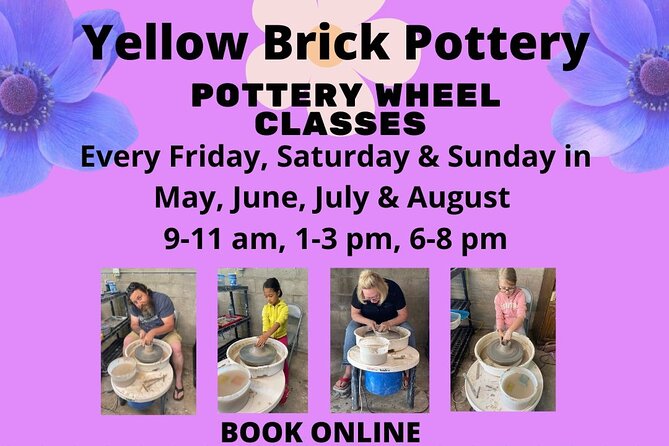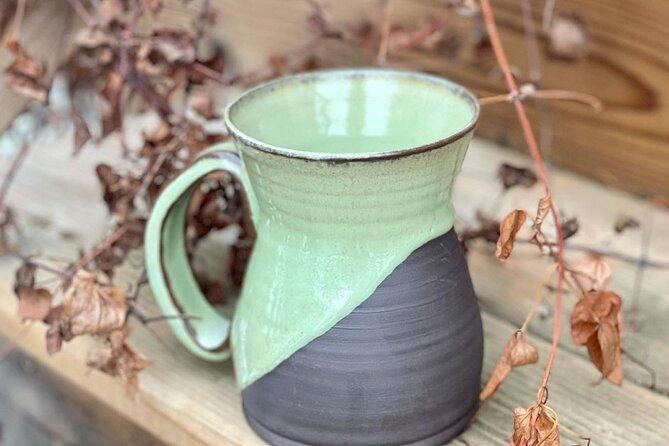The pottery wheel is a captivating tool that unlocks a world of creative possibilities for ceramists. Its simple yet ingenious design – a circular, rotating surface – allows skilled artisans to shape clay into an endless array of intricate and symmetrical forms. Mastering the techniques of centering, opening, pulling, and trimming on the wheel is essential for producing high-quality, professional-grade pottery. From humble beginnings to stunning masterpieces, the pottery wheel has shaped the art of ceramics throughout history. Discover the secrets this remarkable tool holds and uncover the true potential of your creative vision.
Key Points

- A pottery wheel is a rotating device used by potters to shape clay into various forms, allowing for precision and consistency.
- Pottery wheels enable the creation of intricate, symmetrical pieces through techniques like centering, opening, pulling, shaping, and trimming.
- Proper preparation of the pottery wheel, including securing it level and adding a water layer, is crucial for effective clay shaping.
- Essential materials for pottery wheel use include high-quality clay, water, sculpting tools, and turning tools to facilitate the creative process.
- Cleaning and maintaining the pottery wheel, such as wiping down the surface and regular lubrication, ensures smooth operation and extended tool lifespan.
What Is a Pottery Wheel?

A pottery wheel is a rotary device used by potters to shape clay into various forms, such as bowls, vases, and plates.
It consists of a circular, flat surface that spins horizontally, allowing the potter to mold the clay into their desired shape using their hands and tools.
The potter applies pressure and manipulates the spinning clay, gradually forming it into the desired object.
This process requires skill, patience, and a deep understanding of the clay’s properties.
The pottery wheel enables potters to create intricate and symmetrical pieces with a level of precision that would be difficult to achieve through hand-building alone.
It’s a versatile tool that has been used for centuries in the creation of functional and decorative ceramic wares.
You can also read our reviews of more tours and experiences in Ontario.
Benefits of Using a Pottery Wheel

The pottery wheel offers potters a range of benefits that make it an invaluable tool in their craft.
It enables them to achieve a level of precision and consistency in their work that would be difficult to match through hand-building alone. With the wheel’s steady rotation, potters can effortlessly shape clay into symmetrical and intricate forms, unlocking new creative possibilities.
The wheel’s centrifugal force also allows potters to work with larger quantities of clay, facilitating the creation of larger and more ambitious pieces.
Plus, the wheel’s ability to control the speed and pressure applied to the clay gives potters fine-tuned control over the final shape and texture of their work, making it an indispensable asset in the world of pottery.
Materials Needed for Pottery Wheel

Mastering the pottery wheel requires a carefully curated set of materials that enable potters to harness the full potential of this versatile tool.
At the core of this essential toolkit are the clay, water, and tools that allow for the seamless shaping and manipulation of the medium. High-quality clay, with its malleable yet sturdy composition, forms the foundation, while the strategic addition of water creates the ideal workable consistency.
Sculpting tools like ribs, sponges, and wire tools provide the precision and control needed to coax the clay into the desired form, while turning tools like bats and bat pins secure the piece during the shaping process.
With these essential materials, potters can unleash their creativity and produce stunning ceramic works on the pottery wheel.
Preparing the Pottery Wheel
With the essential materials prepped, the potter now turns their focus to properly setting up the pottery wheel.
They ensure the wheel is securely mounted and level, adjusting the height to a comfortable working position. Applying a thin layer of water to the wheel head helps the clay adhere smoothly during the throwing process.
The potter then centers the lump of clay on the spinning wheel, applying gentle pressure to anchor it in place. They may dampen their hands and the clay to prevent sticking as they begin to gently coax the clay into a centered, symmetrical form.
Throughout this process, the potter remains mindful of the wheel’s speed and the clay’s responsiveness, making adjustments as needed to achieve their desired result.
Basic Techniques on the Pottery Wheel

Once the pottery wheel is properly set up and the clay is centered, potters can begin exploring the basic techniques for shaping and forming the clay. They start by applying gentle pressure with their hands, steadying the clay as the wheel spins and gradually coaxing it into an even, symmetrical form. As they gain experience, potters learn to control the wheel’s speed and the placement of their hands to achieve their desired shapes, from simple cylinders to more complex profiles.
| Technique | Description | Key Tips |
|---|---|---|
| Centering | Evenly distributing the clay on the wheel | Apply firm, even pressure with both hands |
| Opening | Creating a centered depression in the clay | Use thumbs to gently push down and out |
| Pulling | Raising the walls of the form | Spread fingers and apply uniform pressure |
| Shaping | Refining the form’s profile | Use hands and tools to smooth and shape |
| Trimming | Cutting the bottom of the form | Use a sharp tool to carefully remove excess clay |
Shaping and Molding on the Pottery Wheel

Budding potters quickly learn to manipulate the spinning wheel, coaxing the clay into desired shapes through a careful interplay of hand movements and wheel speed.
By applying gentle pressure with the palms and fingers, they can create elegant curves and graceful profiles.
Deft centering and shaping techniques allow them to transform simple clay mounds into sophisticated vessels, from delicate cups to sturdy bowls.
As the wheel spins, potters use their senses to feel the clay’s response, adjusting their touch to achieve the perfect form.
It’s a mesmerizing dance of skill and intuition, where the potter’s creativity and the clay’s malleability combine to produce one-of-a-kind works of art.
Finishing Touches on Pottery Wheel Pieces
The potter’s work doesn’t end once the basic form has been shaped on the wheel; they must now apply a series of finishing touches to refine and enhance their creation.
First, they’ll trim the piece, removing excess clay and sculpting the final shape with precision tools.
Next, they’ll add decorative elements like carved patterns or applied textures, bringing visual interest to the surface.
Finally, the potter will apply a glaze – a glassy coating that will melt in the kiln, creating a smooth, glossy finish or a matte, textured effect.
These finishing steps require patience, skill, and an artistic eye to transform the simple wheel-thrown form into a one-of-a-kind ceramic masterpiece.
Cleaning and Maintaining the Pottery Wheel
Proper maintenance and cleaning of the pottery wheel are crucial for its longevity and optimal performance. The potter must regularly clean the wheel’s surface, removing any dried clay or debris that could interfere with the smooth rotation of the wheel. This ensures the wheel spins effortlessly, allowing the potter to focus on their craft.
| Cleaning Steps | Supplies Needed | Frequency |
|---|---|---|
| Wipe Down | Damp cloth, sponge | After each use |
| Deep Clean | Mild detergent, water | Weekly |
| Lubricate | Wheel oil, grease | Monthly |
Maintaining the pottery wheel is a simple yet essential task that helps potters create their best work. By keeping the wheel in pristine condition, potters can enjoy a smooth, reliable, and long-lasting tool for their pottery-making journey.
Frequently Asked Questions
What Is the Minimum Age Requirement to Use the Pottery Wheel?
The minimum age requirement to use the pottery wheel is not specified in the given information. However, most pottery wheel activities are suitable for adults and older children who can safely operate the equipment with proper supervision and instruction.
Can I Bring My Own Tools and Materials to the Session?
Participants can’t bring their own tools and materials to the session. All necessary pottery equipment and supplies will be provided by the instructor for use during the activity. Participants should come prepared to learn and get creative with the provided materials.
How Many Pieces Can I Expect to Complete During the Activity?
Typically, participants can expect to complete 1-2 pieces during the activity, depending on their experience level. The instructor will guide participants through the process of throwing and shaping clay on the pottery wheel.
Is There a Dress Code or Specific Clothing Required for the Workshop?
There’s no strict dress code, but participants should wear casual, comfortable clothing they don’t mind getting a bit dirty. Closed-toe shoes are recommended for safety. The focus is on the pottery-making experience, not fashion.
Can I Keep the Pottery Pieces I Create During the Session?
Participants can indeed keep the pottery pieces they create during the session. The instructor will provide guidance on properly drying and finishing the pieces so attendees can proudly display their handmade creations after the workshop.
Recap
The pottery wheel is an indispensable tool for any aspiring ceramic artist. Mastering its techniques unlocks a world of creative possibilities, allowing potters to shape clay into intricate and symmetrical forms.
From centering the clay to applying the final touches, the pottery wheel empowers artists to bring their visions to life, producing high-quality, professional-grade pottery pieces that showcase their unique talents and artistic flair.
More Tour Reviews in Ontario
- Hiking and Adventure From Napanee to Bon Echo Provincial Park
- Fun City Scavenger Hunt in Greater Sudbury by Zombie Scavengers
- Historical Elora: A Self-Guided Cycle Tour
- Adventurous Scavenger Hunt in Aurora by Zombie Scavengers
- Pickering City Scavenger Hunt Excursion by Zombie Scavengers
- Big Creek Kayak Tour
Not for you? Here's more things to do in Ontario we have recnetly reviewed
- Guided Snowmobile Tours
- Ottawa: Canada Esim Roaming Mobile Data Plan
- Belleville City Scavenger Hunt Excursion by Zombie Scavengers
- Fun City Scavenger Hunt in Belleville by Operation City Quest
- Half-Day White Water Rafting on the Rouge River
- Waterfront Attractions Tour in Sault Saint Marie
- Unique Scavenger Hunt in Sault Ste Marie by Zombie Scavengers
- Fun Scavenger Hunt in Burlington by Zombie Scavengers
- Niagara Falls Airport (IAG) Transportation
- 20 Minute Scenic Helicopter Private Tour
- 1 Hour Singer Castle Express Wildcat 1000 Islands Cruise
- Scavenger Hunt Adventure in North Bay by Zombie Scavengers
